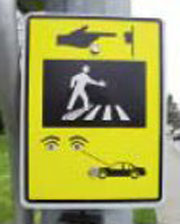City of Richmond Pedestrian Strategy
Richmond, British Columbia, Canada
Source: Pedestrian and Bicycle Information Center (PBIC)
Problem
The city needed an improved pedestrian environment.
Background
One of Richmond City Council's top five priorities for the 2003-2005 term was to improve community mobility and reduce reliance on personal vehicles. In order to meet this goal, the City developed a multifaceted, comprehensive strategy to improve the pedestrian environment and reach the vision of being the "most appealing, livable and well-managed community in Canada."

A sign for pedestrians used in Richmond.
Solution
Richmond's strategy consisted of five main objectives: 1) Enhance pedestrian facilities, 2) Improve accessibility, 3) Educate on safety, 4) Develop a network of trails, and 5) Foster partnerships. The facility improvements were focused on improving pedestrian visibility. Crosswalks in 4-lane and 3-lane roads were upgraded with internally lit overhead signage featuring downward lighting and pedestrian-actuated amber flashers. The downward lighting created a well lit crossing area 24 hours per day and the amber flashers notified drivers when pedestrians were present in the crosswalk. In addition, signage at each special crosswalk illustrated the proper procedure for pedestrians to follow when crossing the street. Funding came through the Arterial Crosswalk Programme, which is identified in the City's annual capital Programme. The $157,000 (Canadian Dollars) allocated per year covers the cost of upgrading about 5 crosswalks. It was expected that upgrades would continue through the year 2010.
Richmond's second objective was to improve the mobility-impaired community's access to transit services. A new "community shuttle" bus service was implemented in 2004, making it the first 100% accessible transit route in Richmond. Wheelchair access at bus stops was improved through the installation of landing pads, connected sidewalks, and where necessary due to topography, railings or extruded curbs. Additionally, audible crosswalk signals were installed in a number of locations for the visually-impaired. An "accessible" signal was still being tested in spring 2007. It included a pole locator sound, pushbutton depress acknowledgement sound, and a tactile component, such as an arrow that vibrates when the walk light is on. Pedestrian signs had a yellow background, as opposed to the national standard of white, due to the color's greater visibility, particularly for the visually impaired. Monies for bus stop upgrades were identified in the Infrastructure Programme, and were all eligible for 50-50 cost sharing with the region's transportation authority (TransLink). Funding for accessible pedestrian signals came out of the general city fund for Traffic Signal Installation.

On the education front, the City developed several safety brochures for motorists and pedestrians, including "Important Safety Tips for Scooter Users," "Traffic Safety Around Schools and Playgrounds," "Slips, Trips, and Falls," and "What to do at Special Crosswalks." All brochures were distributed through the community via city facilities, partner agencies like schools and shopping mall information kiosks, and safety related conferences. Additionally, the city operated a 24-hour phone line for the public to report uneven walking surfaces and other facilities needing attention. The publication of brochures was funded through the Neighborhood Traffic Safety Programme, which receives an average of $165,000 (Canadian Dollars) every two years. This fund also supports traffic calming measures and pathway construction.
At the end of 2003, the Richmond City Council approved the 2010 Richmond Trail Strategy to guide the long-term development of an interconnected network of trails, greenways, blueways, and cycling routes. The goal was to have a city-wide trail of designated cycling route within one kilometer of every resident. Not only did the document contain goals for construction, but also for promoting community use. As a part of the plan, wheelchair ramp design standard was changed to specify two separate ramps at corners. The Trails Capital Programme runs on an annual budget of $250,000 (Canadian Dollars).
Two separate programs fostered partnerships between the city, the Richmond School District, and the Richmond Health Services. The Walkable Richmond Accord provides an overall City policy to encourage a safe and walkable city. Planned events and publications include an annual walk week, neighborhood walking maps, wellness and falls prevention clinics, and walkability checklists for public comment. The Traffic Safety Awareness Week is an annual event hosted by the city School Board, the City, the local auto insurance agency, and auto insurance brokers. The campaign educates students about traffic safety, and encourages walking to school through the "Walking Yellow Wednesday" interschool challenge. The program is funded as a part of the City's on-going traffic safety education strategies.
Results
The crosswalk enhancements seem to have made an improvement, as the upgraded crosswalks were found to have the lowest number of pedestrian-related incidents per location when compared to other types of crosswalks in the city.
As of 2003, the City of Richmond had a higher percentage of accessible bus stops and accessible pedestrian signals than any other municipality in the Greater Vancouver region. Education brochures sent out in 2004 were well-received by the public, and a survey of the general public indicated that 72% of respondents used the Richmond trails either daily or weekly.
The "Walking Yellow Wednesday" challenge has shown consistent success, with more and more schools participating each year: 30 out of 40 schools as of 2004.
Contact
City of Richmond
6911 No. 3 Road
Richmond, BC
V6Y 2C1 Canada
(604) 276-4000
Images Source
Institute of Transportation Engineers Pedestrian Project Award Application. City of Richmond. http://www.ite.org/awards/pedproject/RichmondCanada.pdf




